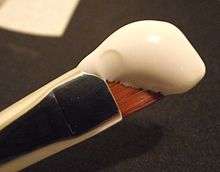Gesso
Gesso (Italian pronunciation: [ˈdʒɛsso]; "chalk", from the Latin: gypsum, from Greek: γύψος) is a white paint mixture consisting of a binder mixed with chalk, gypsum, pigment, or any combination of these.[1] It is used in artwork as a preparation for any number of substrates such as wood panels, canvas and sculpture as a base for paint and other materials that are applied over it.

Description
"Gesso", also known "glue gesso" or "Italian gesso"[2] is a traditional mix of an animal glue binder (usually rabbit-skin glue), chalk, and white pigment, used to coat rigid surfaces such as wooden painting panels as an absorbent primer coat substrate for painting. The colour of gesso is usually white or off-white. Its absorbency makes it work with all painting media, including water-based media, different types of tempera and oil paint. It is also used as a base on three-dimensional surfaces for the application of paint or gold leaf.[3] Mixing and applying it is an art form in itself as it is usually applied in 10 or more extremely thin layers. It is a permanent substrate used on wood, masonite and other surfaces. The standard hide glue mixture is rather brittle and susceptible to cracking, thus making it suitable for rigid surfaces only.
Variations
Half-chalk ground
For priming flexible canvas, an emulsion of gesso and linseed oil, also called "half-chalk ground", is used.[4]
Acrylic gesso
Acrylic gesso is a mixture of white pigment and some kind of filler (chalk, silica, etc.) and acrylic resin dispersed in water. It produces a soft, flexible non-absorbent surface that is technically not gesso at all (although it is commonly called that by its manufacturers).[5][6] It can contain calcium carbonate (CaCO3) to increase the absorbency of the primer coat as well as titanium dioxide or "titanium white" as a whitening agent. It is sold premixed for both sizing and priming panels and flexible canvas for painting. Art supply manufacturers market canvases pre-primed with acrylic gesso.
Acrylic gesso can be colored, either commercially by replacing the titanium white with another pigment, such as carbon black, or by the artist directly, with the addition of an acrylic paint. Acrylic gesso can be odorous, due to the presence of ammonia and/or formaldehyde, which are added in small amounts as preservatives.
Acrylic gesso's non-absorbent acrylic polymer base makes it incompatible with media that require traditional gesso such as egg tempera.[7] The Painter's Handbook notes a problem with using oil paints over an acrylic gesso ground instead of a traditional oil ground, citing a mismatch in flexibility over time that could cause the oil paint to delaminate.[8]
Use in sculpture
Gesso is used by sculptors to prepare the shape of the final sculpture (fused bronze) or directly as a material for sculpting. Gesso can also be used as a layer between sculpted wood and gold leaf [9]. In this case, a layer of refined and coloured clay, called ‘bole’ is used to cover the gesso before applying the gold [10]. This is usually red in colour.
See also
References and sources
- References
- Daniel Varney Thompson. The materials and techniques of medieval painting. p. 32. Retrieved 2014-04-09 – via Books.google.com.
- The Painter's Handbook: A Complete Reference by Mark David Gottsegen. p. 321 Archived June 3, 2015, at the Wayback Machine
- Lettering & Calligraphy Workbook. Diagram Group. p. 148. Retrieved 2014-04-09 – via Books.google.com.
- The Painter's Handbook: A Complete Reference by Mark David Gottsegen, p. 64
- The Painter's Handbook: A Complete Reference, by Mark David Gottsegen. p. 321 Archived June 3, 2015, at the Wayback Machine
- Michael Friel (2010). Still Life Painting Atelier: An Introduction to Oil Painting. Random House Digital, Inc. p. 58. Retrieved 2014-04-09 – via Books.google.com.
- Altoon Sultan. Luminous Brush: Painting with Egg Tempera. p. 33. Retrieved 2014-04-09 – via Books.google.com.
- Gottsegen, Mark David (2006). Painter's Handbook: Revised and Expanded (Revised, Expanded ed.). New York: Watson-Guptill. p. 60. ISBN 978-0-8230-3496-3.
- "What Does That Do: Gesso Carving Chisels". Chicago: The Conservation Center. November 29, 2017. Retrieved May 23, 2020. Cite magazine requires
|magazine=(help) - Thompson, Daniel V. (2012). The Materials and Techniques of Medieval Painting. Dover Publications. p. 219. ISBN 9780486142036.
- Sources
- "The Technique of Raised Gilding" by Jerry Tresser, 1992.
Further reading
- Crane, Walter (May 1893). "Gesso Work". The Studio. 1 (2): 45–49.
External links
